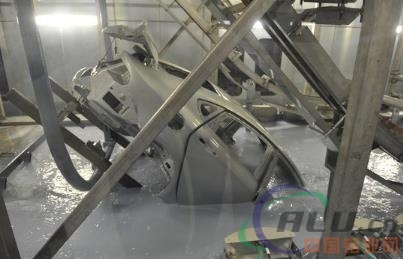
Privacy statement: Your privacy is very important to Us. Our company promises not to disclose your personal information to any external company with out your explicit permission.
[China Aluminum Industry Network] Cathodic electrophoretic coatings for automotive components have earlier performance Automotive parts (such as steel wheels, frames, etc.) are used dip lacquer (epoxy asphalt paint) and spray paint (spray solvent coating, alcohol Acid paints, lacquers, etc.) Surface protection, poor corrosion resistance (salt spray less than 100h), and fire hazard.
In order to solve this problem, in the 1960s and the 1970s, anodized electrophoretic coating was used as an alternative to impregnating lacquer, and pure phenolic and epoxy anode electrophoretic paints were used. Although the fire risk was avoided, the corrosion resistance and impregnation were quite.

In the 20th century, in the 20th century, polybutadiene anodized electrophoretic paints were developed to increase the corrosion resistance to more than 240 hours. So far, some black paint parts under cars use polydiene anode electrophoretic paints.
Due to the improvement of the anti-corrosion performance standards of the whole vehicle, the anode electrophoretic paint can not meet the requirements of the products. In the 1990s, some automotive parts began to be coated by cathodic electrophoresis, typically represented by truck cars, frames, wheels, etc. The department has 100% of car parts using cathodic electrodeposition coating technology.
1 In recent years, some assembly parts and components have not only corrosion resistance requirements, but also certain weathering requirements, such as commercial vehicle frame, and most of them use electrophoretic paints with good weather resistance.
2 Requires ≥ 60 cycles for the cyclical corrosion alternation of the rear axle, subframe, and other parts of the car.
(B) Cathodic electrophoretic coating applications for automotive parts
1. Workshop task Cathode electrophoretic coating lines for car chassis parts of a certain factory are mainly pre-treatment of chassis structural parts and cathodic electrophoretic coating tasks.
2. The annual production capacity of the three-shift production system is 500,000 sets, and the equipment utilization rate is calculated at 90%. The size of the hanging basket is 2200mm×1000mm×1600mm, and two hanging baskets can be hung in each suspension. The number of linked cranes is estimated to be 65,000 per year. The average weight of single-mounted work pieces (2 rack baskets) is 212kg, and the average area is 28m2.
3. Work system and annual base number The serial number of the department adopts the shift class hours of work hours h years base number h I class II class III class equipment station 1, class 2 class 3 class workers 1 2 production department auxiliary department.
4, design principles
1 Using thick-film cathodic electrophoresis, the outer surface of the coating thickness ≥ 35μm, the inner surface ≥ 25μm, salt spray resistance test ≥ 1440h (60 cycles).
2 Mechanized transport uses a combination of program-controlled traffic and ground conveyors.
3 The pretreatment, electrophoresis and electrophoresis are followed by full immersion or spray leaching. The heating source of the bath is steam.
4 The "II" shaped drying room is used, and the energy source is natural gas.
5. Process and description No. Process name Process time Min Temperature °C Section length m Transportation method Remarks
1. White-loaded manual 5 RT program-controlled traffic T=5.5min/T
2, pre-processing entrance
2.1 hot water spray 2 65 ± 5 plus insulation cover transition section
2.2 pre-degreasing spray 2 60 ± 5 plus insulation cover transition section
2.3 Degreasing dipping 3 60±5 plus insulation cover plate and laminar flow system transition section
2.4 Wash Spray 1 RT Transition Section
2.5. Washing immersion/spraying 1 RT out spout Spray fresh water transition
2.6 Table Tuning 1.5 RT Transition Section
2.7 Phosphating immersion 3 50-55 plus insulation cover plate and laminar flow system transition section
2.8 Wash Spray 1 RT Transition Section
2.9 Washing Dipping/Spraying 1 RT Outlet Spraying Fresh Water Transition Section
2.10 passivation dip 1RT transition section
2.11 Pure Water Wash Dip/Spray 1 RT Outlet Spray Fresh Tap Water
3 Drainage platform 4 Cathodic electrophoresis
4 28——34 Spraying fresh UF liquid transition section
5, rinse RT after electrophoresis
5.1 UF wash spray 1 transition section
5.2 UF immersion/spray 1 slot for spraying fresh UF fluid, and electrophoresis tank transition section
5.3 Pure Water Wash Dip/Spray 1 RT Outlet Spray Fresh Fresh Water Transition Section
6 drain platform
7 Reproduced manual 5 RT cross machine can be rotated 90 °C
8 electrophoresis drying hot air circulation 40 170±10 elevator sliding chain T=1.8mm V=0.4m/min
9 strong cold 15 ≤ 40 roller conveyor
10 Unloading manual 5 roller conveyor
September 19, 2022
September 09, 2022
September 08, 2022
September 09, 2022
November 03, 2022
이 업체에게 이메일로 보내기
September 19, 2022
September 09, 2022
September 08, 2022
September 09, 2022
November 03, 2022

Privacy statement: Your privacy is very important to Us. Our company promises not to disclose your personal information to any external company with out your explicit permission.

Fill in more information so that we can get in touch with you faster
Privacy statement: Your privacy is very important to Us. Our company promises not to disclose your personal information to any external company with out your explicit permission.